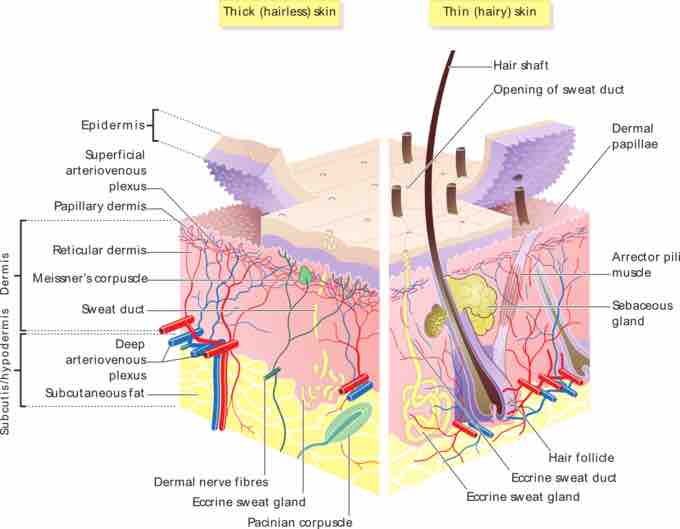The Cutaneous Membrane
The cutaneous membrane is the technical term for our skin. The skin’s primary role is to help protect the rest of the body’s tissues and organs from physical damage such as abrasions, chemical damage such as detergents, and biological damage from microorganisms. For example, while the skin harbors many permanent and transient bacteria, these bacteria are unable to enter the body when healthy, intact skin is present.
Our skin is made of three general layers. In order from most superficial to deepest they are the epidermis, dermis, and subcutaneous tissue.
The Epidermis
The epidermis is a thin layer of skin. It is the most superficial layer of skin, the layer you see with your eyes when you look at the skin anywhere on your body. Functions of the epidermis include touch sensation and protection against microorganisms.
This skin is further divided into five, separate layers. In order from most superficial to deepest, they are the:
Stratum Corneum
This layer is composed of the many dead skin cells that you shed into the environment—as a result, these cells are found in dust throughout your home. This layer helps to repel water.
Stratum Lucidum
This layer is found only on the palms of the hands, fingertips, and the soles of the feet.
Stratum Granulosum
This is the layer where part of keratin production occurs. Keratin is a protein that is the main component of skin.
Stratum Spinosum
This layer gives the skin strength as well as flexibility.
Stratum Basale
This is where the skin’s most important cells, called keratinocytes, are formed before moving up to the surface of the epidermis and being shed into the environment as dead skin cells.
This layer also contains melanocytes, the cells that are largely responsible for determining the color of our skin and protecting our skin from the harmful effects of UV radiation. These harmful effects include burns in the short term and cancer in the long run.
The Dermis
Underneath the epidermis lies the dermis. The dermis contains:
- Blood vessels that nourish the skin with oxygen and nutrients. The blood vessels also allow immune system cells to come to the skin to fight an infection. These vessels also help carry away waste products.
- Nerves that help us relay signals coming from the skin. These signals include touch, temperature, pressure, pain, and itching.
- Various glands.
- Hair follicles.
- Collagen, a protein that is responsible for giving skin strength and a bit of elasticity.
The Subcutaneous Tissue
The deepest layer of the skin is called the subcutaneous layer, the subcutis, or the hypodermis. Like the dermis, the layer contains blood vessels and nerves for much the same reasons.
Importantly, the subcutis contains a layer of fat. This layer of fat works alongside the blood vessels to maintain an appropriate body temperature. The layer of fat here acts as a cushion against physical trauma to internal organs, muscles, and bones.
Additionally, the body will turn to this fat in times of starvation to provide power to its various processes, especially brain function.

Layers of cutaneous membranes (skin)
This image details features of the epidermal and dermal layers of the skin.